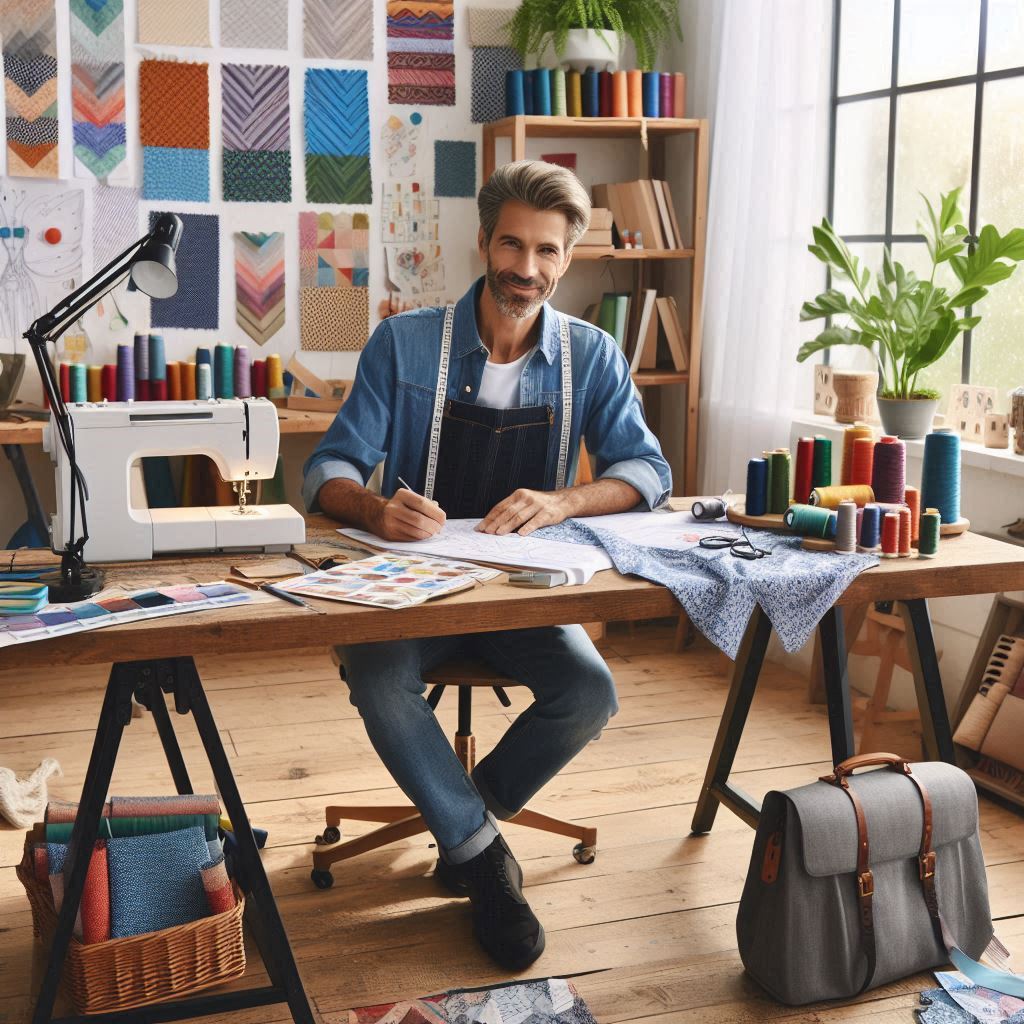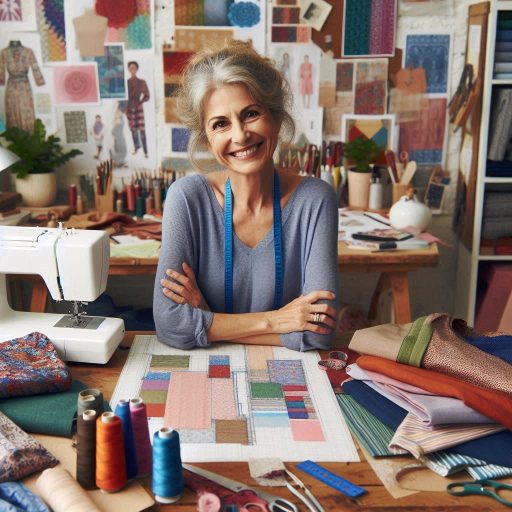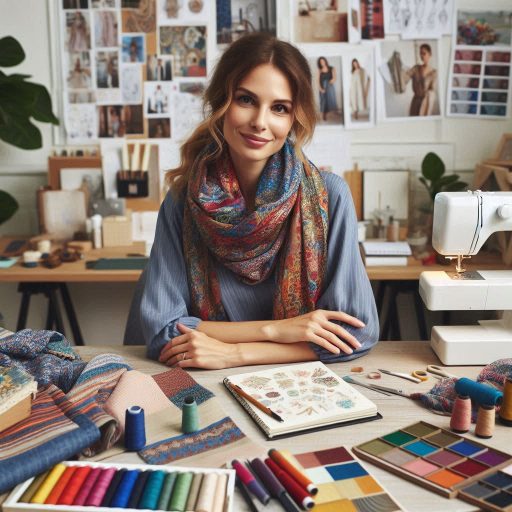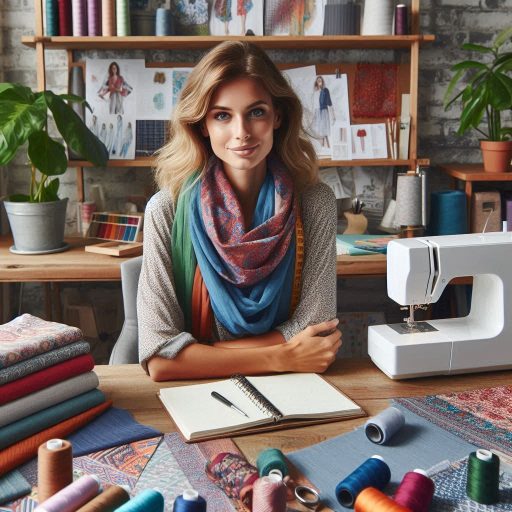Introduction
Patterns and prints are fundamental to textile design, adding character and visual interest to fabrics.
Their importance cannot be overstated, as they help define the mood, style, and purpose of textiles.
Whether it’s for fashion, interior design, or commercial purposes, patterns and prints serve as a creative language, transforming simple fabrics into vibrant, meaningful pieces.
They allow designers to tell stories, create moods, and set trends.
Patterns and prints have the power to enhance the overall look and feel of textiles.
The right pattern can elevate a fabric from functional to expressive, adding depth and texture.
Prints can influence how a fabric is perceived—soft florals might evoke a sense of calm, while bold geometric patterns can make a statement.
These elements not only enhance visual appeal but also play a role in how fabrics are used, whether in clothing, home décor, or accessories.
There are many types of patterns and prints commonly used in textile design.
Geometric patterns, with their clean lines and structured forms, give a modern, minimalist aesthetic.
Florals are timeless, offering a natural and often romantic feel.
Abstract prints inspire creativity and can represent anything from bold artistic expressions to subtle, unstructured designs.
Stripes and plaids, on the other hand, are classic and versatile, adding a sense of order and balance.
History of Patterns and Prints in Textile Design
The origins of patterns and prints in textile design
Patterns and prints have played a significant role in textile design throughout history.
Their origins can be traced back to ancient civilizations.
Early humans used natural dyes and simple motifs to create patterns.
These early designs often depicted elements from their surroundings, such as animals and plants.
How different cultures and time periods have influenced the development of patterns and prints
As societies evolved, so did textile patterns.
In ancient Egypt, intricate geometric patterns adorned clothing and household textiles.
The Egyptians developed techniques for dyeing and weaving that influenced future generations.
Their use of color and design reflected their beliefs and social status.
In Asia, particularly in China, patterns gained prominence with the invention of silk.
The Chinese created elaborate motifs inspired by nature and mythology.
Floral designs and dragons became symbols of power and prosperity.
The use of indigo dye in Japanese textiles also led to distinct patterns.
Shibori, a traditional dyeing technique, created unique and complex designs.
The Renaissance marked a pivotal moment in textile design.
European artisans began to experiment with printing techniques.
The introduction of woodblock printing allowed for more intricate designs.
Patterns featuring floral motifs and elaborate scrolls became popular in fabrics.
These prints were often used in garments for the nobility, showcasing wealth and sophistication.
Key moments in history where certain patterns and prints gained popularity
The Industrial Revolution further transformed textile patterns.
The introduction of mechanized printing methods allowed for mass production.
This innovation made printed fabrics more accessible to the general public.
Patterns became bolder and more diverse during this period.
Floral, paisley, and damask designs dominated the market.
In the 20th century, patterns in textile design underwent significant changes.
Artists and designers began to break traditional boundaries.
Movements such as Art Deco and Bauhaus emphasized geometric shapes and modern aesthetics.
These styles influenced the development of contemporary textile patterns.
Bright colors and abstract designs became popular in home décor and fashion.
Globalization also played a crucial role in the evolution of textile patterns.
Different cultures began to influence each other more than ever before.
Traditional motifs from Africa, Asia, and South America found their way into Western designs.
This fusion of styles created a rich tapestry of patterns and prints.
Today, patterns and prints continue to evolve, reflecting modern trends and cultural influences.
Sustainable practices have emerged, leading to a renewed interest in traditional techniques.
Designers now explore eco-friendly dyes and organic materials.
The history of patterns and prints in textile design highlights humanity’s creativity and adaptability.
Each design tells a story, connecting us to our past while inspiring future innovations.
Read: Top Skills Needed for Art Educators and Instructors
Types of Patterns in Textile Design
The Different Types of Patterns such as Floral, Geometric, Abstract, and Figurative
Textile design includes a wide range of patterns that cater to different styles and moods.
Floral patterns are inspired by nature, featuring flowers, leaves, and botanical elements.
These patterns are often associated with elegance, femininity, and beauty.
Geometric patterns use shapes like circles, triangles, and squares.
They create a sense of balance, order, and modernity.
Abstract patterns break away from recognizable forms, offering more freedom in design and interpretation.
Finally, figurative patterns showcase objects, animals, or human figures, providing a more representational and narrative design.
Examples and Visual Aids to Showcase Each Type of Pattern
Examples of floral patterns can be seen in traditional wallpapers or summer dresses that use soft, pastel-colored flowers to evoke a sense of calm.
Geometric patterns are visible in modern home decor, such as rugs featuring clean lines and angular shapes.
Abstract art can inspire abstract patterns in textiles, using splashes of bold color or irregular shapes to create visually engaging designs.
Figurative patterns are popular in children’s clothing, where you might find prints of animals, cartoon characters, or simple human figures, adding a fun and playful touch.
How Different Patterns Can Evoke Different Emotions and Aesthetics in Textiles
Each type of pattern can affect how a textile feels and what emotions it evokes.
Floral patterns are often calming and soothing, making them ideal for home decor or summer wear, where a relaxing vibe is essential.
Geometric patterns convey a sense of order, stability, and modernity, making them popular in minimalistic designs.
Abstract patterns, with their unpredictability, evoke creativity and excitement.
They are often used to make bold statements.
Figurative patterns, on the other hand, can be more personal, playful, or nostalgic, depending on the subject matter, and often tell a story.
Read: Collaborating with Other Creative Roles
Types of Prints in Textile Design
Define What Prints Are in the Context of Textile Design
In textile design, prints refer to the process of applying patterns, designs, or images onto fabric surfaces.
Unlike woven or embroidered patterns, which are created during the fabric’s construction, prints are applied to the fabric after it has been produced.
Prints allow designers to incorporate a wide range of colors, patterns, and images onto textiles, providing flexibility in design while maintaining cost-effectiveness.
Prints are essential for creating visually engaging fabrics used in clothing, home decor, and more.
Techniques Used to Create Prints such as Screen Printing, Digital Printing, and Block Printing
There are several techniques used in textile printing, each offering different effects.
Screen printing is one of the most traditional methods, involving a stencil placed on a screen, through which ink is pressed onto fabric.
This method is known for its vivid colors and durability, ideal for mass production.
Digital printing is a newer technique that uses specialized printers to apply the design directly onto the fabric.
It offers precision, the ability to use a wide range of colors, and is great for creating intricate designs.
Block printing is an ancient method where wooden or metal blocks are carved with designs and stamped onto the fabric by hand.
This technique creates unique, handcrafted patterns with slight variations, offering an artisanal aesthetic.
Showcase Examples of Prints and Discuss Their Impact on Textile Design
Screen-printed fabrics are often found in high-quality t-shirts, tote bags, and upholstery where durability and vibrant colors are key.
The technique is widely used in fashion and home decor.
Digitally printed textiles are prevalent in fast fashion due to the speed of production and the ability to replicate intricate designs.
You’ll find it in detailed patterns on dresses, scarves, and decorative pillows.
Block-printed textiles are popular in traditional crafts, often used in artisanal clothing, table linens, or wall hangings where a rustic or handcrafted look is desired.
Each printing technique affects the aesthetic and feel of a textile.
Screen printing offers bold, sharp designs that stand out, while digital printing provides fine details and photographic-quality images.
Block printing delivers an organic, hand-crafted feel, giving each piece a unique character.
Together, these printing techniques allow textile designers to experiment with creativity, catering to a wide range of styles and markets.
Read: Historic Costume Design Inspirations

Color Theory in Patterns and Prints
The Role of Color in Patterns and Prints
Color plays a fundamental role in patterns and prints, shaping how a textile is perceived and experienced.
In textile design, color can highlight specific elements within a pattern, bring contrast, and evoke various emotional responses.
Whether a designer aims to create a bold, eye-catching print or a subtle, soothing pattern, color choice is essential in determining the overall aesthetic.
Proper use of color can enhance a design’s impact, making it either harmonious or dramatic, depending on the intended effect.
How Color Choices Can Affect the Overall Look and Feel of a Textile Design
Color choices significantly influence the look and feel of a textile design.
Warm colors like reds, oranges, and yellows create energy, excitement, and warmth, often used in bold or vibrant patterns.
Cool colors like blues, greens, and purples evoke calmness, tranquility, and sophistication, often chosen for designs that aim to soothe or relax.
Neutral tones such as grays, beiges, and whites provide a minimalist, modern feel and are often used in more understated or versatile designs.
High contrast color combinations like black and white create sharp, visually striking patterns, while monochromatic schemes using variations of one color create a more cohesive, subtle look.
When designing textiles, the relationship between colors can create entirely different effects.
For instance, complementary colors, such as blue and orange, create high-energy contrast, while analogous colors, such as green and yellow, provide a more harmonious blend.
Designers can manipulate the color palette to match the intended mood, theme, or functionality of the fabric.
Tips on How to Choose Colors that Complement Each Other in Patterns and Prints
To create harmonious and visually appealing patterns and prints, follow these tips:
- Use a Color Wheel: A color wheel helps identify complementary, analogous, and triadic color schemes.
Complementary colors (opposite on the wheel) create contrast, while analogous colors (next to each other) offer harmony. - Stick to a Limited Palette: Avoid overwhelming the design with too many colors.
Limiting the palette to three or four colors ensures a cohesive and focused look. - Consider the Context: Think about where the textile will be used.
Bold, vibrant colors might work for fashion but could overwhelm a home decor setting. - Incorporate Neutrals: Balancing bright or bold colors with neutral tones like gray, white, or beige can soften a design and add elegance.
- Play with Shade Variations: Use different shades or tints of a color to add depth and dimension to a pattern without overpowering the design.
By choosing the right color combinations, designers can elevate patterns and prints, making them more versatile, attractive, and emotionally resonant.
Read: Breaking Down Iconic Movie Costumes
Mixing and Matching Patterns and Prints
Tips on How to Effectively Mix and Match Patterns and Prints in Textile Design
Mixing and matching patterns and prints can create dynamic and visually engaging textiles, but it requires a careful approach.
Start by choosing a consistent color palette.
Using similar or complementary colors helps unify different patterns, making them feel cohesive.
Next, balance bold patterns with simpler ones.
For example, pair a busy floral print with a subtle geometric pattern to avoid overwhelming the design.
Another tip is to mix different types of patterns, such as combining florals with stripes or abstract prints with polka dots, to create contrast while maintaining visual interest.
Discuss the Concept of Scale and Balance When Combining Different Patterns and Prints
When mixing patterns, scale plays a crucial role.
Combining patterns of different sizes creates a balanced look.
For example, mix a large-scale floral print with smaller, delicate geometric shapes to ensure that the patterns complement each other without competing.
Similarly, pairing a bold, oversized abstract print with a smaller, more detailed pattern helps maintain balance.
The concept of balance ensures that the design remains harmonious, with no single pattern overpowering the others.
This balance is key to making mixed patterns look intentional and stylish rather than chaotic.
Transform Your Career Today
Unlock a personalized career strategy that drives real results. Get tailored advice and a roadmap designed just for you.
Start NowProvide Examples of Successful Pattern Mixing in Textiles
A successful example of pattern mixing in textiles is the combination of stripes and florals.
Stripes, with their clean, linear structure, create order and balance when paired with the organic shapes of florals.
Another example is polka dots and geometric patterns.
Polka dots, being playful and round, can soften the angularity of geometric designs, resulting in a balanced and visually engaging textile.
In home decor, mixing plaids with abstract prints is another effective combination.
The structured look of plaid provides a sense of order, while abstract prints add artistic flair.
Similarly, animal prints paired with minimalist designs create an edgy yet refined look, where the boldness of animal prints is toned down by the simplicity of minimalist patterns.
By following these principles of scale, balance, and complementary colors, mixing and matching patterns and prints can transform a textile into an eye-catching and creative design.
Trend Forecasting in Patterns and Prints
The Importance of Trend Forecasting in Textile Design
Trend forecasting is essential in textile design as it helps designers stay relevant and competitive.
It involves predicting upcoming patterns, prints, colors, and styles that will be popular in future seasons.
Forecasting allows designers to create textiles that resonate with consumer preferences and market demands.
By anticipating trends, brands can position themselves at the forefront of fashion, home decor, and other industries that rely heavily on textile designs.
This foresight not only enhances sales potential but also ensures that designers produce textiles that reflect current cultural and aesthetic shifts.
How Designers Can Stay Up-to-Date with the Latest Trends in Patterns and Prints
Designers can stay current with the latest trends in patterns and prints by leveraging various resources.
Trend forecasting agencies like WGSN and Pantone provide insights into future design directions, including color palettes and popular motifs.
Fashion weeks and trade shows are also key platforms where designers can observe upcoming patterns and print trends.
Staying active on social media platforms like Instagram and Pinterest can provide real-time insights into consumer preferences.
Additionally, subscribing to design magazines and industry reports offers valuable information on emerging trends in textile design.
Highlight Upcoming Trends in Patterns and Prints for the Current Season
For the current season, nature-inspired patterns are expected to dominate, with prints featuring florals, leaves, and organic shapes becoming increasingly popular.
These patterns reflect the growing trend of sustainability and eco-conscious living.
Another upcoming trend is bold geometric prints, which are gaining traction in both fashion and interior design.
These designs focus on striking lines, sharp angles, and vibrant colors, adding a modern, dynamic edge to textiles.
Abstract and painterly prints are also on the rise, offering a more artistic and expressive look.
These prints often feature brushstrokes, splashes of color, and irregular shapes, creating a sense of creativity and freedom.
Animal prints, particularly in unconventional colors like pastel or neon, continue to be a staple in fashion, providing an edgy yet playful aesthetic.
As minimalism and functionality remain important, monochromatic patterns with subtle texture are emerging in home decor.
These patterns offer a clean, sophisticated look while maintaining visual interest through slight variations in texture and depth.
By staying attuned to these trends, designers can create textiles that not only appeal to modern tastes but also push the boundaries of creativity in pattern and print design.
Sustainability in Patterns and Prints
The Impact of Patterns and Prints on the Environment
Patterns and prints in textile design can significantly impact the environment, particularly through the production processes involved.
Traditional textile manufacturing often relies on synthetic dyes and non-biodegradable materials, leading to pollution and waste.
The dyeing process, for instance, consumes vast amounts of water and can release harmful chemicals into waterways, harming aquatic ecosystems.
Additionally, the fast fashion industry, characterized by rapid production and consumption cycles, exacerbates waste and pollution.
As a result, the textiles we design and produce have a direct correlation with environmental sustainability, necessitating a shift toward more eco-friendly practices.
Explore Sustainable Practices in Textile Design Such as Using Organic Dyes and Recycled Materials
Sustainable practices in textile design aim to minimize environmental impact while maintaining aesthetic appeal.
One such practice involves using organic dyes derived from natural sources like plants, fruits, and minerals.
These dyes are less harmful to the environment, producing less waste and pollution during the dyeing process.
Furthermore, utilizing recycled materials, such as reclaimed fabrics or fibers from post-consumer products, can significantly reduce waste and resource consumption.
Designers can also consider biodegradable materials, which break down more naturally and lessen long-term environmental impact.
Another approach is digital printing, which uses less water and generates fewer chemicals compared to traditional printing methods.
This technique allows for intricate designs while promoting sustainability by reducing the overall environmental footprint of textile production.
Tips on How Designers Can Create Eco-Friendly Patterns and Prints
Designers can create eco-friendly patterns and prints by following these tips:
- Choose Sustainable Materials: Opt for organic cotton, linen, or bamboo, which have a lower environmental impact compared to conventional fabrics.
- Use Natural Dyes: Experiment with plant-based or mineral dyes to achieve vibrant colors while minimizing harm to the environment.
- Embrace Minimalism: Consider simpler patterns that require less dye and material, reducing waste and resource consumption.
- Implement Digital Printing: Leverage digital printing technology to minimize water usage and chemical waste during the printing process.
- Incorporate Upcycled Elements: Use leftover fabric scraps or vintage materials in designs to reduce waste and promote creativity.
- Design for Longevity: Create patterns and prints that are timeless, encouraging consumers to invest in quality over quantity and reduce fast fashion’s impact.
- Educate Consumers: Share information about the environmental benefits of sustainable practices, helping consumers make informed choices about their textile purchases.
By adopting these sustainable practices, designers can significantly contribute to a more eco-friendly textile industry, reducing the environmental impact of patterns and prints while creating beautiful, responsible designs.
Conclusion
Understanding patterns and prints is vital for anyone involved in textile design, whether a novice or an experienced professional.
Patterns and prints possess the unique ability to transform ordinary fabrics into captivating visual narratives that can evoke emotions and convey messages.
Throughout this blog, we have explored various aspects of textile design, highlighting how patterns can influence the overall aesthetic of a garment or interior space.
Mastering patterns and prints opens doors to countless creative possibilities, allowing designers to create pieces that truly stand out in a competitive market.
We discussed the importance of key elements such as color, scale, and repetition in creating balanced and harmonious designs.
Each of these factors plays a critical role in ensuring that a pattern not only looks appealing but also effectively communicates the intended message or feeling to the audience.
For instance, a bold, large-scale print can make a statement, while a subtle, intricate pattern might invite closer inspection and appreciation.
Understanding how these elements interact will enable designers to craft textiles that resonate with their target audience.
Additionally, incorporating various types of patterns—be it geometric, floral, or abstract—can open new avenues for creativity, enabling designers to tap into diverse cultural inspirations and trends.
Moreover, the beauty of textile design lies in its diversity and flexibility.
The ability to experiment with different combinations of patterns and prints can lead to innovative and unexpected outcomes.




